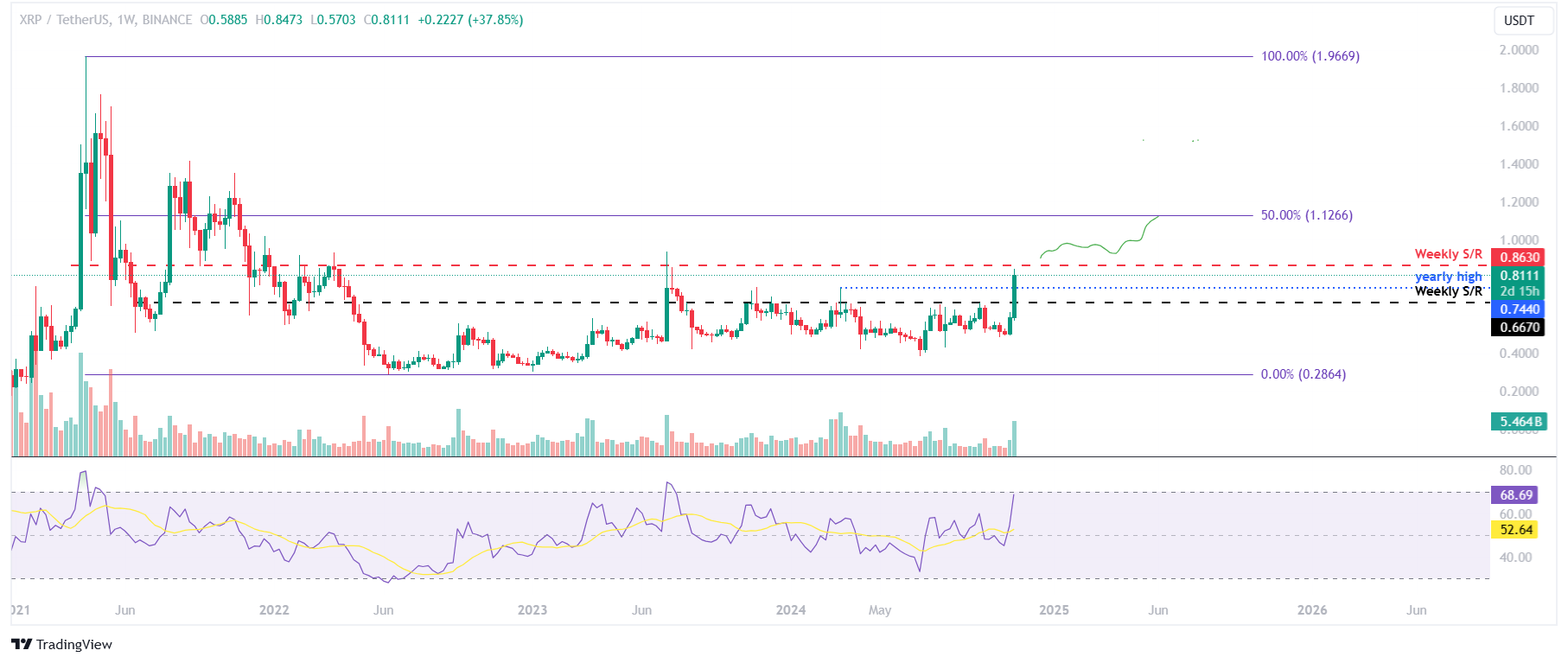Ripple surges to new 2024 high on XRP Robinhood listing, Gensler departure talk
- Ripple price rallies almost 6% on Friday, extending the 12% increase seen on Thursday, following Robinhood’s listing of XRP on its exchange.
- XRP reacts positively to recent speculation about Chair Gary Gensler leaving the US Securities and Exchange Commission.
- SG-FORGE plans to deploy its Euro stablecoin, EURCV, on the XRP Ledger network.
Ripple (XRP) extends its gain on Friday after rallying over 30% since Monday and reaching a new year-to-date high of $0.847. The main reasons for the rally are the listing of XRP on the US exchange Robinhood and speculation about the US Securities and Exchange Commission (SEC) Chair Gary Gensler’s resignation as Ripple is facing a long-standing legal battle with the regulator.
Another factor favoring the XRP price outlook comes from SG-FORGE, a subsidiary of French bank Societe Generale, which said it plans to deploy its Euro stablecoin, EURCV, on the XRP Ledger network.
Why is Ripple going up today?
Ripple price extends its gains by almost 6% on Friday after a 12% surge, reaching a new yearly high the previous day at $0.847. The main reasons for the recent price surge are:
First, the listing of Ripple on the US exchange Robinhood on Wednesday, along with other coins such as Solana (SOL), Cardano (ADA) and Pepe (PEPE). The listing is a positive sign for the accessibility and liquidity of the token. This renewed interest from exchanges will likely attract investors and traders to the XRP token.
https://t.co/Sk0wi6ET10
— Robinhood (@RobinhoodApp) November 14, 2024
Secondly, there is increasing talk about the possible resignation of Gary Gensler as the SEC’s chair.
In a speech on Thursday, reproduced on the SEC official website, Gensler used some words hinting at a potential departure.
“It’s been a great honor to serve with them,” he said, referring to the SEC staff. “I’ve been proud to serve with my colleagues at the SEC who, day in and day out, work to protect American families on the highways of finance,” he added. Neither the SEC nor Gensler himself have confirmed any resignation.
However, the market is reacting positively to hints of Gary Gensler’s potential departure as they foresee an end to the “regulation by enforcement” approach to crypto, which has hit Ripple particularly hard.
Analysts consider that a new, more pro-crypto SEC chair could lead to a favorable outcome in the legal battle between the SEC and Ripple, unlocking XRP’s full potential and leading to its broader acceptance in the financial ecosystem.
Ripple’s weekly chart shows that its price broke above the weekly resistance of $0.744 this week, reaching a new year-to-date high of $0.847, and is nearing the key resistance level of $0.863.
If there is a weekly close above $0.863, XRP could extend the rally to retest its next target at $1.26, which aligns with the 50% price retracement level drawn from the April 2021 high of $1.96 to the June 2022 low of $0.286.
The Relative Strength Index (RSI) on the weekly chart reads at 68, well above its neutral level of 50, indicating bullish momentum is strong.

XRP/USDT weekly chart
Some other good news for Ripple
On Thursday, SG-FORGE, the digital assets-focused subsidiary of French bank Societe Generale, announced that it will launch its euro stablecoin, EUR CoinVertible (EURCV), on the XRP Ledger (XRPL) network by 2025.
SG-FORGE, which is deploying XRPL, wants to benefit from the network’s cross-border payment and tokenization capabilities, it said.
Ripple stablecoin RLUSD is set to launch this year. The token is “operationally ready,” awaiting regulatory approval by the New York Department of Financial Services.
.@SocieteGenerale-Forge has announced the launch of its EURCV stablecoin on the XRP Ledger in 2025.
— RippleX (@RippleXDev) November 14, 2024
With Ripple Custody powering the integration, EURCV will benefit from the near-instant settlement, low fees, scalability and security of the #XRPL.https://t.co/36vh7BGXxh
SEC vs Ripple lawsuit FAQs
It depends on the transaction, according to a court ruling released on July 14, 2023: For institutional investors or over-the-counter sales, XRP is a security. For retail investors who bought the token via programmatic sales on exchanges, on-demand liquidity services and other platforms, XRP is not a security.
The United States Securities & Exchange Commission (SEC) accused Ripple and its executives of raising more than $1.3 billion through an unregistered asset offering of the XRP token. While the judge ruled that programmatic sales aren’t considered securities, sales of XRP tokens to institutional investors are indeed investment contracts. In this last case, Ripple did breach the US securities law and had to pay a $125 million civil fine.
The ruling offers a partial win for both Ripple and the SEC, depending on what one looks at. Ripple gets a big win over the fact that programmatic sales aren’t considered securities, and this could bode well for the broader crypto sector as most of the assets eyed by the SEC’s crackdown are handled by decentralized entities that sold their tokens mostly to retail investors via exchange platforms, experts say. Still, the ruling doesn’t help much to answer the key question of what makes a digital asset a security, so it isn’t clear yet if this lawsuit will set precedent for other open cases that affect dozens of digital assets. Topics such as which is the right degree of decentralization to avoid the “security” label or where to draw the line between institutional and programmatic sales persist.
The SEC has stepped up its enforcement actions toward the blockchain and digital assets industry, filing charges against platforms such as Coinbase or Binance for allegedly violating the US Securities law. The SEC claims that the majority of crypto assets are securities and thus subject to strict regulation. While defendants can use parts of Ripple’s ruling in their favor, the SEC can also find reasons in it to keep its current strategy of regulation by enforcement.

